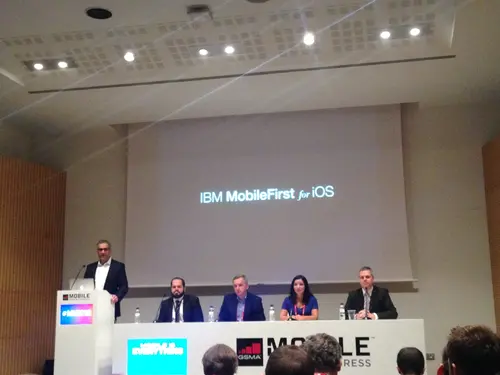
BARCELONA, Spain — When Ashi Hoseini, manager of mobile solutions for Scandinavian Airlines (SAS), began talking to IBM about creating apps that might help its crews be more efficient, she got the kind of offer several techies can only dream about:
An offer to fly to Cupertino and work directly with Apple developers at its headquarters.
A few days afterwards, she and her team left with a new app that its crews can use on iOS devices that will be rolling out soon.
“Our vision is to make life easier for our customers, in this case our employees,” she said. “This new app has the power of simplicity married with the power of analytics. And that was thanks to the design teams of IBM and Apple.”
Hoseini made her remarks this week at a panel hosted by IBM at the Mobile World Congress 2016 in Barcelona. And there are so several jarring things about the event that it’s hard to know how to begin listing them.
Apple and IBM announced a partnership around enterprise solutions back in July 2014. While Apple has seen its mobile gadgets like the iPhone and iPad being used at work as individuals purchase them, it's remained a bigger challenge to get large enterprises to adopt them on the kind of massive scale that might turn around the slumping sales of its tablet.
IBM is deep, deep in the enterprise. So while the partnership is entirely logical, it’s also still remarkable to see the historic rivals working shoulder-to-shoulder. Seeing IBM executives stand in front of a sign at MWC that reads “IBM MobileFirst for iOS” takes some adjustment.
Beyond that, the ultra-secretive Apple prefers to pretty much never talk about its inner workings. And more specifically, it officially avoids such mega trade shows even if it looms large over them.
While there were no Apple execs in attendance at the IBM press conference, the IBM execs on stage and their customers were more than happy to offer up details of how the partnership is working on the ground. And that in turn shows how hard Apple is working to educate and inspire potential enterprise customers that it is eager to bring into its customer fold.
The case of SAS seems to be pretty typical of the approach. IBM and Apple have created dedicated teams that work at the Apple campus to help customers like SAS. While Apple has lots of developer outreach in general, teaching businesses to use enterprise apps is far more complex because they likely have to plug into existing infrastructure and various databases to work seamlessly.
In other words, these are not just two programmers building another photo sharing app.
In an interview, Phil Buckellew, vice president of enterprise mobile at IBM, said the teams meld Apple’s historic strength in design and IBM’s depth in analytics and data. “These mix of skills is really critical,” he said.
When Hoseini arrived in Cupertino, her team included not just IT people from SAS, however, some pilots and cabin crew members as well. During her time there, she said Apple was relentless about its design-thinking approach which starts with the people will actually use the product. As such, they advise companies to bring the actual users and developers to the boot camps.
The problem, from the SAS side, is that crews are under mounting pressure to turn flights around quickly after they arrive. This is putting more stress on the employees who are increasingly dealing with frustrated customers who are asking questions about arrivals and delays. With the app, Passenger Plus, those crews will have detailed information about airports, flights, taxi times at their fingertips in the hopes they can answer more questions and better manage the transition between arrival and departure.
Throughout the process, the SAS team wanted more functionality and information. Hoseini said Apple’s and IBM’s teams helped find a balance between access to that information while keeping the design of the app simple to use.
“We changed the dashboard to make it more informative,” she said. “We did that without losing the lean and clean look of the app.”
So far, this partnership has led to the creation of 100 enterprise apps. If that doesn’t sound like a huge number, remember that when these get rolled out at massive companies, it drives the need to buy large amounts of Apple gadgets and IBM data and consulting services.
IBM is clearly bullish on the partnership, and is pushing it ahead with a strong embrace of Apple’s Swift programming language.
Buckellew said that Swift has become of the world’s fastest growing programming languages since Apple introduced it in 2014. Apple made Swift open source in December, and he expects that to only accelerate its adoption in the coming years.
Indeed, IBM had several announcements at MWC this week about cloud-based services for Swift.
“Swift is making it easier for developers to build great apps,” Buckellew said. “And IBM is making it even easier to use Swift.”
“
. .